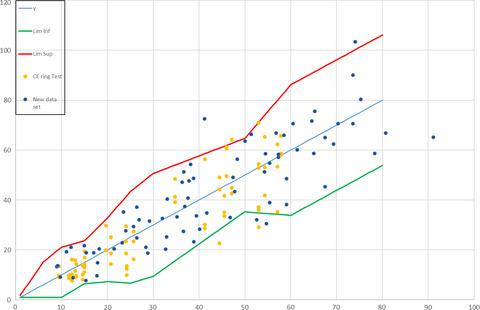当前位置:
X-MOL 学术
›
Int. J. Cosmet. Sci.
›
论文详情
Our official English website, www.x-mol.net, welcomes your
feedback! (Note: you will need to create a separate account there.)
Validation of a new in vitro Sun Protection Factor method to include a wide range of sunscreen product emulsion types.
International Journal of Cosmetic Science ( IF 2.7 ) Pub Date : 2020-05-10 , DOI: 10.1111/ics.12625 M Pissavini 1 , C Tricaud 2 , G Wiener 3 , A Lauer 4 , M Contier 5 , L Kolbe 6 , C Trullás Cabanas 7 , F Boyer 8 , E Meredith 9 , J de Lapuente 10 , E Dietrich 11 , P J Matts 12
International Journal of Cosmetic Science ( IF 2.7 ) Pub Date : 2020-05-10 , DOI: 10.1111/ics.12625 M Pissavini 1 , C Tricaud 2 , G Wiener 3 , A Lauer 4 , M Contier 5 , L Kolbe 6 , C Trullás Cabanas 7 , F Boyer 8 , E Meredith 9 , J de Lapuente 10 , E Dietrich 11 , P J Matts 12
Affiliation

|
In 2017, Cosmetics Europe performed a double‐blinded ring test of 24 emulsion‐type sunscreen products, across 3 in vivo test laboratories and 3 in vitro test laboratories, using a new candidate in vitro SPF test method. Based on the results of this work, an article was published showing how data derived from a new lead candidate method conform to new International Standards (ISO) acceptance criteria for alternative SPF test methods (Any alternative method should consider the matrix effect and if required, specify the matrix applicability of the method; Criterion 1a: Systematic differences between methods should be negligible: 95% of all individual results of an alternative method are within the range of ±2× reproducibility standard deviation of the in vivo method, that is overall bias must be below 0.5× reproducibility standard deviation of the in vivo method; Criterion 1b: Measurement uncertainty of an alternative method should be below the measurement uncertainty of the in vivo method. Candidate method predicted values must fall within the full ‘funnel’ (SPF 6‐50+) limits proposed by Cosmetics Europe (derived from the same minimum test design, that is using the ISO24444 Method to measure at least 24 products across at least 3 laboratories using at least 5 test subjects/laboratory, in a blinded fashion).). Of the 24 sunscreen products tested, the majority of emulsions were of the oil‐in‐water (O/W) type, whereas only one was water‐in‐oil (W/O) and there were no products with a mineral‐only sun filter system. In order to confirm the scope of this method, therefore, a new study was conducted that included 73 W/O (12 mineral + organic, 44 mineral only and 17 organic only) and 3 O/W mineral‐only, emulsion‐type sunscreen products (a total of 76 new sunscreen products). When combined with the previous 24 products (tested in 3 different laboratories), this yielded a new data set comprising a total of 100 emulsion‐type sunscreen products, with SPF values ranging from 6 to 50+ (with a total of 148 data points). These products were tested using the double‐plate in vitro SPF test method and compared with the ISO TC217/WG7 acceptance criteria for alternative SPF test methods. Over 95% of paired in vitro: in vivo SPF values lay within the upper and lower limits of the ISO acceptance criteria funnel, with no bias. This new in vitro SPF test method, therefore, meets the minimum requirements for an alternative SPF test method to ISO24444:2010, for emulsion‐type sunscreen products (which make up the majority of marketed sunscreen products).
中文翻译:

验证一种新的体外防晒系数方法,包括多种防晒产品乳液类型。
2017 年,Cosmetics Europe 对 24 款乳液型防晒产品进行了双盲环测试,跨越 3个体内测试实验室和 3个体外测试实验室,使用一种新的候选体外SPF 测试方法。基于这项工作的结果,发表了一篇文章,展示了从新的主要候选方法中获得的数据如何符合替代 SPF 测试方法的新国际标准 (ISO) 接受标准(任何替代方法都应考虑基质效应,如果需要,指定方法的矩阵适用性;标准 1a:方法之间的系统差异应可以忽略不计:替代方法的所有单个结果的 95% 在±2×重现性标准偏差的范围内体内方法,即总体偏差必须低于体内方法的重现性标准偏差的 0.5 倍;标准 1b:替代方法的测量不确定度应低于体内测量的不确定度方法。候选方法的预测值必须落在 Cosmetics Europe 提出的完整“漏斗”(SPF 6-50+) 限制范围内(源自相同的最低测试设计,即使用 ISO24444 方法测量至少 3 个实验室中的至少 24 种产品使用至少 5 个测试对象/实验室,以不知情的方式))。在测试的 24 款防晒产品中,大多数乳液是水包油 (O/W) 型,而只有一种是油包水 (W/O),没有产品仅含有矿物质阳光过滤系统。因此,为了确认该方法的适用范围,进行了一项新研究,其中包括 73 W/O(12 种矿物质 + 有机,44 种纯矿物质和 17 种纯有机)和 3 O/W 纯矿物质乳液型防晒霜产品(共76款防晒新品)。结合之前的 24 种产品(在 3 个不同实验室进行测试),这产生了一个新的数据集,包括总共 100 种乳液型防晒产品,SPF 值范围从 6 到 50+(共有 148 个数据点) . 这些产品使用双板进行测试体外SPF 测试方法,并与 ISO TC217/WG7 替代 SPF 测试方法的验收标准进行比较。超过 95% 的体外配对:体内SPF 值位于 ISO 验收标准漏斗的上限和下限内,没有偏差。因此,这种新的体外SPF 测试方法符合 ISO24444:2010 的替代 SPF 测试方法的最低要求,适用于乳液型防晒产品(占市售防晒产品的大部分)。
更新日期:2020-05-10
中文翻译:

验证一种新的体外防晒系数方法,包括多种防晒产品乳液类型。
2017 年,Cosmetics Europe 对 24 款乳液型防晒产品进行了双盲环测试,跨越 3个体内测试实验室和 3个体外测试实验室,使用一种新的候选体外SPF 测试方法。基于这项工作的结果,发表了一篇文章,展示了从新的主要候选方法中获得的数据如何符合替代 SPF 测试方法的新国际标准 (ISO) 接受标准(任何替代方法都应考虑基质效应,如果需要,指定方法的矩阵适用性;标准 1a:方法之间的系统差异应可以忽略不计:替代方法的所有单个结果的 95% 在±2×重现性标准偏差的范围内体内方法,即总体偏差必须低于体内方法的重现性标准偏差的 0.5 倍;标准 1b:替代方法的测量不确定度应低于体内测量的不确定度方法。候选方法的预测值必须落在 Cosmetics Europe 提出的完整“漏斗”(SPF 6-50+) 限制范围内(源自相同的最低测试设计,即使用 ISO24444 方法测量至少 3 个实验室中的至少 24 种产品使用至少 5 个测试对象/实验室,以不知情的方式))。在测试的 24 款防晒产品中,大多数乳液是水包油 (O/W) 型,而只有一种是油包水 (W/O),没有产品仅含有矿物质阳光过滤系统。因此,为了确认该方法的适用范围,进行了一项新研究,其中包括 73 W/O(12 种矿物质 + 有机,44 种纯矿物质和 17 种纯有机)和 3 O/W 纯矿物质乳液型防晒霜产品(共76款防晒新品)。结合之前的 24 种产品(在 3 个不同实验室进行测试),这产生了一个新的数据集,包括总共 100 种乳液型防晒产品,SPF 值范围从 6 到 50+(共有 148 个数据点) . 这些产品使用双板进行测试体外SPF 测试方法,并与 ISO TC217/WG7 替代 SPF 测试方法的验收标准进行比较。超过 95% 的体外配对:体内SPF 值位于 ISO 验收标准漏斗的上限和下限内,没有偏差。因此,这种新的体外SPF 测试方法符合 ISO24444:2010 的替代 SPF 测试方法的最低要求,适用于乳液型防晒产品(占市售防晒产品的大部分)。











































 京公网安备 11010802027423号
京公网安备 11010802027423号